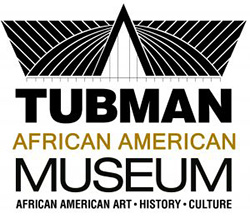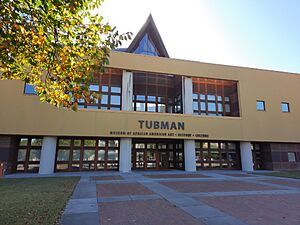Tubman Museum facts for kids
 |
|

Front entrance of the Tubman Museum
|
|
| Former name | Harriet Tubman Historical and Cultural Museum |
|---|---|
| Established | 1981 |
| Location | Macon, Georgia |
| Type | Art museum |
| Founder | Richard Keil |
| Public transit access | Terminal Station |
| Nearest parking | on-street and back parking lot |
The Tubman Museum is a special place in Macon, Georgia, USA. It used to be called the "Tubman African American Museum." This museum is in a part of the city with other museums, like the Georgia Music Hall of Fame and the Georgia Sports Hall of Fame. It helps people learn about African American art, history, and culture.
Contents
History of the Museum
Where the Museum Started
The Tubman Museum was founded in 1981. It was created to save and show important African American art, history, and culture. For many years, the museum was located on Dr. Martin Luther King, Jr., Drive. This building was about 8,500 square feet in size.
In 2015, the museum moved to a brand new, much larger building. The new building is 49,500 square feet. It is located near Terminal Station and across from the Georgia Sports Hall of Fame. Plans for this new building began way back in 2001. There were some delays because of money problems around 2007-2008.
The old museum building closed on April 10, 2015. The new museum opened its doors on May 16, 2015. This big opening happened during the Pan-African Festival in Downtown Macon. People even marched from the old museum to the new one for the ribbon-cutting ceremony!
What the Museum Does
The main goal of the Tubman Museum is to teach everyone about African American culture and history. It has many different exhibits, programs, and books. These are for everyone, from young students to college students and the general public.
The museum also offers fun classes. You can learn dancing, drama, drumming, photography, and visual art. All these classes focus on African American culture.
How the Museum Began
The idea for the Tubman Museum came from Reverend Richard Keil. He was a Catholic priest who worked in many churches, mostly in the South. He had dreamed of starting a museum for over 20 years. When he came to St. Peter Claver Church in Macon, he felt it was the perfect spot. Macon was easy to get to and in a central location.
In 1981, Reverend Keil talked with many African American community leaders. He found a building on Walnut Street and used his own money to make a down payment and get a loan. He believed others would help support the museum.
Reverend Keil wanted to start the museum because he saw a need. He felt there were not enough places to learn about black history. He wanted a center that would show African American culture in a positive way. He also felt that history books often didn't talk enough about the great things black Americans had achieved.
Many people helped Reverend Keil make his dream come true. Some of these helpers included high school principal Gloria Washington and Mercer University professor Bobby Jones. Contractor Albert Billingslea and his wife Margaret also helped. Pearlie and John T Oliver, along with Maureen Walker, were also very important in getting the museum started.
The museum moved to its current location on Cherry Street in 2015. Today, its leaders say it is the largest museum in the Southeast that focuses on African American art, history, and culture.
Art at the Museum
Amazing Galleries and Exhibits
The Tubman Museum has many interesting galleries and exhibitions. One famous piece is From Africa to America. This is a large mural painted by a Macon artist named Wilfred Stroud. The mural shows important events from African history leading up to America, starting in 1619.
The museum also has other cool galleries. These include I Dream a World: Portraits of Black Women Who Changed America. Another is Sankofa: A Century of African American Expression in the Decorative Arts. The museum also has different art collections like The Mural, Inventors Gallery, Local History, Folk Art, and Black Artist of Georgia.
See also

